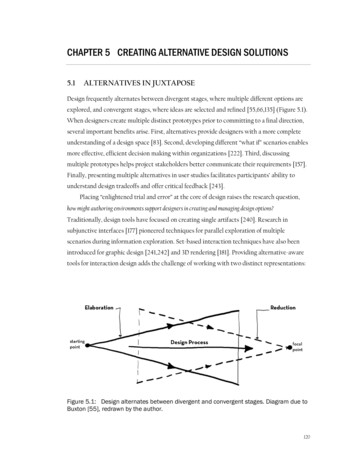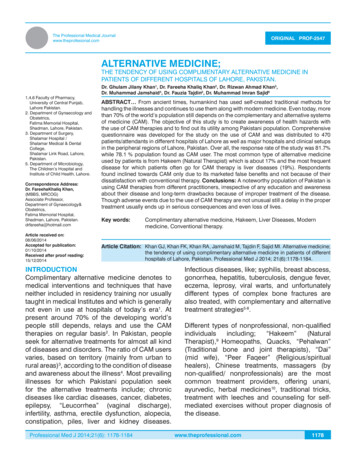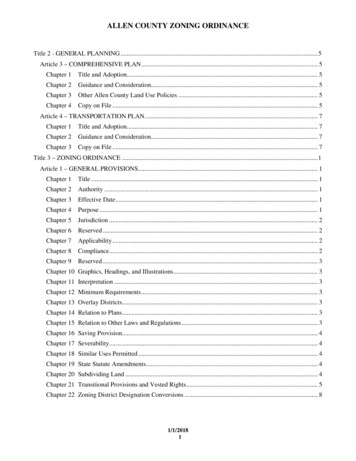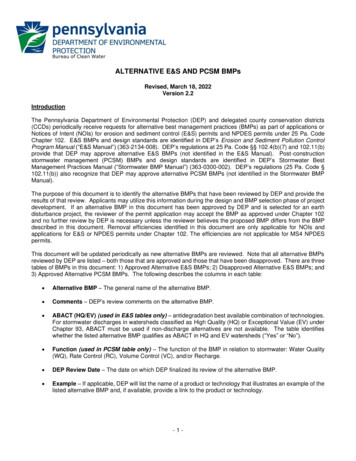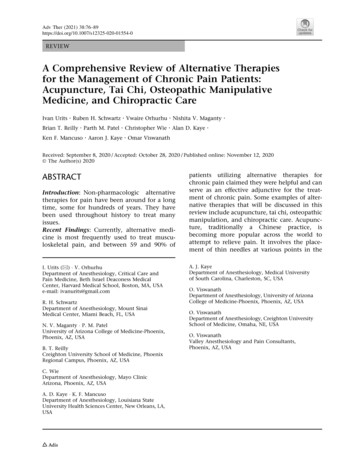
Transcription
Adv Ther (2021) -0REVIEWA Comprehensive Review of Alternative Therapiesfor the Management of Chronic Pain Patients:Acupuncture, Tai Chi, Osteopathic ManipulativeMedicine, and Chiropractic CareIvan Urits . Ruben H. Schwartz . Vwaire Orhurhu . Nishita V. Maganty .Brian T. Reilly . Parth M. Patel . Christopher Wie . Alan D. Kaye .Ken F. Mancuso . Aaron J. Kaye . Omar ViswanathReceived: September 8, 2020 / Accepted: October 28, 2020 / Published online: November 12, 2020Ó The Author(s) 2020ABSTRACTIntroduction: Non-pharmacologic alternativetherapies for pain have been around for a longtime, some for hundreds of years. They havebeen used throughout history to treat manyissues.Recent Findings: Currently, alternative medicine is most frequently used to treat musculoskeletal pain, and between 59 and 90% ofI. Urits (&) V. OrhurhuDepartment of Anesthesiology, Critical Care andPain Medicine, Beth Israel Deaconess MedicalCenter, Harvard Medical School, Boston, MA, USAe-mail: ivanurits@gmail.comR. H. SchwartzDepartment of Anesthesiology, Mount SinaiMedical Center, Miami Beach, FL, USAN. V. Maganty P. M. PatelUniversity of Arizona College of Medicine-Phoenix,Phoenix, AZ, USAB. T. ReillyCreighton University School of Medicine, PhoenixRegional Campus, Phoenix, AZ, USAC. WieDepartment of Anesthesiology, Mayo ClinicArizona, Phoenix, AZ, USAA. D. Kaye K. F. MancusoDepartment of Anesthesiology, Louisiana StateUniversity Health Sciences Center, New Orleans, LA,USApatients utilizing alternative therapies forchronic pain claimed they were helpful and canserve as an effective adjunctive for the treatment of chronic pain. Some examples of alternative therapies that will be discussed in thisreview include acupuncture, tai chi, osteopathicmanipulation, and chiropractic care. Acupuncture, traditionally a Chinese practice, isbecoming more popular across the world toattempt to relieve pain. It involves the placement of thin needles at various points in theA. J. KayeDepartment of Anesthesiology, Medical Universityof South Carolina, Charleston, SC, USAO. ViswanathDepartment of Anesthesiology, University of ArizonaCollege of Medicine-Phoenix, Phoenix, AZ, USAO. ViswanathDepartment of Anesthesiology, Creighton UniversitySchool of Medicine, Omaha, NE, USAO. ViswanathValley Anesthesiology and Pain Consultants,Phoenix, AZ, USA
Adv Ther (2021) 38:76–89body. The efficacy of acupuncture for pain isheavily debated. More research and discussionare necessary to determine the exact role it playsin the treatment of chronic pain. Tai chi is alsoa traditional Chinese practice that is often usedas a form of meditation and for potential healthbenefits. Tai chi involves a series of complexmovements such as squatting combined withdeep breathing to achieve relaxation and painreduction. Osteopathic manipulative treatment(OMT) is a technique used by both osteopathicphysicians (DO) as well as other health professionals to manage a wide range of conditions inany given patient. The technique involves utilization and manipulation of the musculoskeletal system to achieve potential healthbenefits. OMT has been used as therapy formany issues but is commonly used for painconditions.Summary: Alternative therapies may serve asan effective adjunctive treatment modality forthe management of chronic pain conditions.There has been a tremendous amount ofresearch dictating the effectiveness of alternative therapies for chronic pain management.The purpose of this review is to provide acomprehensive evidence-based update of alternative therapy used for the management ofchronic pain conditions.Keywords: Acupuncture;Chiropractor;Osteopathic manipulative treatment; Pain; TaichiKey Summary PointsAlternative therapies provide evidencebased options for patients dealing withchronic pain to avoid unwanted opioiduse.These techniques have been utilized forcenturies with proven results.Tai chi, acupuncture, and osteopathicmanipulation therapy are all viableoptions for improving mobility andreducing pain symptomatology.77DIGITAL FEATURESThis article is published with digital features,including a summary slide, to facilitate understanding of the article. To view digital featuresfor this article go to DUCTIONPain occurs in 30.7% of adults [1]. Between 9and 12 million people in the US suffer fromchronic pain [2]. Chronic pain is incrediblydebilitating and comes in many different forms.Some different types of chronic pain includeneuropathic, nociceptive, and nociplastic pain.It is associated with decreased function bothphysically and emotionally as well as a decreasein quality of life [3]. Additionally, the total costburden due to chronic pain in the US is estimated to be between 560 and 635 billiondollars annually [3]. There are many ways tomanage pain. Pharmaceutical therapy is usuallythe first choice with opioid therapy often beingconsidered for severe chronic pain. Patients thatrequire opioids for pain relief usually haveexhausted more conservative analgesics such asnon-steroidal anti-inflammatories and acetaminophen. Opioids, despite being highlyaddictive, are still one of the most prescribedpharmaceuticals for this particular issue. Thereare five opioid medications in the top 200 mostprescribed drugs in the US and one within thetop 10 [4]. The increase in opioid use in the USis multifactorial. However, many attribute theincrease over the years to both the introductionof pain as the fifth vital sign in the 1990s andthe aggressive marketing of OxyContin by Purdue Pharma [5, 6]. A 2019 literature reviewnoted that around 6% of the US abused opioidsin some form [2]. Prescription opioids are oftendescribed as a ‘‘gateway into the drug culture’’[7]. The rise in prescription opioid abuse hasbeen linked to increases in heroin and syntheticopioid (fentanyl, etc.) related deaths with a 20%and 72% bump in overdose deaths as a result ofthese substances, respectively [5]. Deaths fromopioid overdose have risen 156% from 2010 to
Adv Ther (2021) 38:76–89782015 [8]. There are alternative medicationsavailable to treat daily pain. NSAIDs are one ofthe most common classes of non-opioid painmedication. These drugs may not adequatelycontrol pain and are associated with increasedrisk of gastrointestinal ulcers and bleeding[9, 10]. Several other classes of drugs such asantidepressants and muscle relaxants are oftenprescribed for pain, but have weak evidence forefficacy against chronic pain [10]. Non-pharmacologic alternative therapies for pain havebeen around for a long time, some for hundredsof years. They have been used throughout history to treat many issues. Currently, alternativemedicine is most frequently used to treat musculoskeletal pain and between 59 and 90% ofpatients utilizing alternative therapies forchronic pain claimed them to be ‘‘helpful’’ [11].Based on these findings, it appears that alternative therapies can serve as an effectiveadjunctive for the treatment of chronic pain.Some examples of alternative therapies thatwill be discussed in this review includeacupuncture, tai chi, osteopathic manipulation,and chiropractic care. Acupuncture, traditionally a Chinese practice, is becoming more popular across the world to attempt to relieve pain.It involves the placement of thin needles atvarious points in the body. A 2012 meta-analysis of nearly 18,000 patients found acupuncture to be better than sham and no acupuncturetherapy for chronic pain control [12]. However,the efficacy of acupuncture for pain is heavilydebated. More research and discussion are necessary to determine the exact role it plays in thetreatment of pain [13]. Tai chi is also a traditional Chinese practice that is often used as aform of meditation and for potential healthbenefits. Tai chi involves a series of complexmovements such as squatting combined withdeep breathing to achieve relaxation and painreduction [14]. An overview of currentCochrane reviews regarding physical activitiesand chronic pain suggests that interventionssuch as tai chi are potentially beneficial inreducing chronic pain and increasing quality oflife; however, additional research is neededbefore specific recommendations can be made[15]. Osteopathic manipulative treatment(OMT) is a technique used by both osteopathicphysicians (DO) as well as other health professionals to manage a wide range of conditions inany given patient. The technique involves utilization and manipulation of the musculoskeletal system to achieve potential healthbenefits. OMT has been used as therapy formany issues but is commonly used for painconditions. A systematic review of OMT for lowback and pelvic pain after surgery showed evidence suggesting moderate reduction in painfor these conditions following OMT [16]. Chiropractic care is a practice founded in the 1890sthat is a well-established form of alternativemedicine in the western world. Like OMT, itfocuses on manual manipulation of the body totreat issues with the musculoskeletal system.Chiropractic care is very controversial, especially in the discussion of chronic pain. There isa clear need to step away from opioids in themanagement of chronic pain given the currentepidemic. Alternative therapies are needed toaid in management of chronic pain so there is areduced focus on opioid pain management.Chronic pain, unlike acute pain, often does nothave a discernable physiologic cause or pathology [17]. Therefore, alternative therapies such asthose discussed above may serve to be a reasonable alternative to opioids for managementof chronic pain conditions. We focused ourreview on the most prevalent form of pain inthe patient population, low back pain. In thisreview, we will be discussing the benefit of utilizing alternative medicine approaches to thepatient with chronic pain. This article is basedon previously conducted studies and does notcontain any studies with human participants oranimals performed by any of the authors.ACUPUNCTURELow Back PainAcupuncture, a form of alternative medicinethat originated in China over 3000 years ago,has been increasingly used for pain management. There are a number of forms ofacupuncture including needling, moxibustion,and cupping [18]. Needling involves insertingneedles, typically 32–36 gauge, into specific
Adv Ther (2021) 38:76–89acupuncture points on the body. Needles can bemade of ceramic, bronze, iron, gold, silver, orstainless steel. In electroacupuncture, a currentis applied through the needle. Laser acupuncture uses non-thermal laser irradiation onstandard acupuncture points. Moxibustion utilizes burning moxa above the skin near pressurepoints. Finally, cupping is a technique in whichbamboo, glass, or ceramic cups are used to create a vacuum over the acupuncture points [19].Nearly 400 acupoints have been describesworldwide, located on nearly 20 meridians, orchannels of energy. The goal of acupuncture isto promote flow of Qi, the essence of life,through the meridians [20].Although acupuncture has been used in avariety of clinical disorders, it is most frequentlyused for chronic pain management. Acupuncture is beneficial for low back pain up to 2 yearsafter treatment. In a randomized controlled trial(RCT) of 241 patients aged 18–64, acupuncturewas found to have a significantly favorableeffect on the SF-36. Patients who had receivedten acupuncture sessions over 3 months had a5.6-point increase on the SF-36 at 12 monthsand an 8.0-point increase at 24 months compared to those receiving standard treatment.Furthermore, the patients that receivedacupuncture reported lower scores on theOswestry Disability Index (ODI) and McGillpain measure, although this was not statisticallysignificant. There were no severe adverse effectsof acupuncture reported in this study [21]. Inanother RCT, 130 adults with low back painwere randomized to receive acupuncture orsham acupuncture twice weekly for 6 weeks.Patients who received true acupuncture reported lower scores for pain compared to those thatreceived sham acupuncture. Sham acupuncturein this study was defined by using blunt needleswithout penetration on acupuncture points.This demonstrates that acupuncture has morethan a placebo psychologic effect and there is aphysiologic mechanism underlying its success[22]. In addition, standard acupuncture therapyis shown to be equally effective to individualized therapy for patients [23]. Electroacupuncture has been shown to be effective in thetreatment of chronic sciatica. In a study of 100patientsrandomizedtoreceive79electroacupuncture versus medium frequencyelectrotherapy, there was a significantimprovement in pain based on ODI scores inthe electroacupuncture group [24]. In addition,results of a randomized double-blind trial illustrated that laser acupuncture using cups with afrequency of 200 Hz and output power of50 mW resulted in similar pain reduction andquality of life scores as a sham laser cuppingcontrol. This demonstrates that cupping itselfmay provide a therapeutic effect for low backpain. One limitation of the study was that lasertherapy was only studied for three treatments[25].PregnancyAcupuncture may also be a useful treatment inpregnancy-related low back pain. The prevalence of low back pain during pregnancy isestimated to be between 30 and 70% [26]. Backpain in pregnancy is due to a combination ofhormonal, mechanical, and motor changes. Anenlarging uterus to carry a growing fetus causesincreased strain on the lumbar spine, whichresults in low back pain. The enlarging uteruscauses abdominal muscles to stretch significantly resulting in a decrease in strength andcoordination of the lumbopelvic muscles, particularly the gluteus medius. Finally, a hormonereleased by the placenta called relaxin isthought to weaken joint strength, resulting inlow back pain [27]. Acupuncture is an emergingtreatment for pregnancy-related low back pain.In the EASE back pilot trial, 125 pregnantpatients were randomized to receive standardcare for back pain, standard care plus shamacupuncture, or standard care plus trueacupuncture. After six treatments over 8 weeks,patients receiving sham acupuncture and trueacupuncture endorsed improvement in painand physical health. Patients reported no difference in quality of life but stated that they hadfewer nighttime awakenings and sleep disturbances due to back pain. Earlier studies suggested that acupuncture may lead to pre-termlabor in pregnant patients; however, recent literature, including the EASE back trial, reportedno serious adverse events associated with
Adv Ther (2021) 38:76–8980acupuncture in pregnancy. The most commonside effects include lightheadedness and pain atthe acupuncture site [26]. A Cochrane reviewpublished in 2015 reported that there was nosignificant difference in sham acupuncture withprenatal care and true acupuncture with prenatal care in pregnant patients with pelvic pain.However, compared to prenatal care alone,acupuncture results in moderate improvementin pelvic pain [28]. Acupuncture may also haveutility in improving labor pain. A Cochranereview published in 2011 stated acupunctureused at variety of acupoints resulted in areduction of labor pain. Patients were also moresatisfied with acupuncture as a pain treatmentcompared to standard treatment [29]. Twostudies published in 2011 demonstrated thatpatients who received electroacupuncture during labor had a significant reduction in pain[30].MigrainesAcupuncture is a useful treatment in the management of migraines. A 2016 Cochrane reviewevaluated 22 RCTs with over 4000 participantsand found that acupuncture resulted in a 50%reduction of migraines in 41% of the patients.Acupuncture was superior to sham acupuncturein reduction of migraines, and a small benefitwas found even 12 months after treatment [31].In a study of 20 women suffering from chronicmigraines, ear acupuncture resulted in a reduction of migraine attacks per month in 37.5% ofwomen [32]. When combined with tuina therapy, a form of therapeutic massage, acupuncture may be more effective in treatingmigraines. In an RCT of 45 patients, thosereceiving tuina therapy combined withacupuncture compared with those receivingacupuncture alone or control therapy had asignificant reduction in attack frequency,severity of pain, and duration of migraine. Thecombination of tuina with acupuncture resultedin less analgesic use by patients in the trial [33].Although acupuncture appears to be effective inrelieving migraines, its mechanism of action isnot well understood. In an animal study,acupuncture resulted in a decrease in theexpression of 5-HT7R, a serotonin pathway, andsubsequent alleviation of migraine symptoms[34]. Magnetic resonance spectroscopy pre- andpost-acupuncture found a significant increase inN-acetylaspartate and creatine in the thalamus[35]. Future studies are necessary to betterunderstand the mechanism behind acupuncture and duration of symptom relief.Complex Regional Pain Syndrome (CRPS)Complex regional pain syndrome (CRPS) is achronic neuropathic pain syndrome believed tobe caused by inflammation or damage to thenervous system after an injury. CRPS is commonly managed with NSAIDs, steroids, antidepressants, and regional pain blocks. It can oftenbe resistant to these forms of standard paintreatment. Acupuncture may be an importanttreatment option for CRPS. In a case report of a29-year-old man with CRPS after polydactylyresection, bee venom acupuncture resulted insignificant reduction in pain. After 14 over3 months, the patient reported complete resolution of pain symptoms and no longer neededanalgesic medications [36]. In another casereport, ultrasound-guided dry needling resultedin almost complete improvement of pain andmotor dysfunction within 2 months of treatment. In animal studies, electroacupuncture isthought to work by inhibiting mechanicalhyperalgesia and edema in chronic post-ischemia pain mouse models. This effect isenhanced when electroacupucture is used inconjunction with endothelin receptor type B(ETB) antagonists [37].The efficacy of acupuncture for chronic painconditions is summarized in Table 1.TAI CHILow Back PainTai chi is a Chinese mind-body exercise that hasbeen used for health promotion and diseaseprevention in Asia for hundreds of years. InAmerica, the prevalence of tai chi practice hasgrown steadily since 2002, with a 14.5%
Adv Ther (2021) 38:76–8981Table 1 Efficacy of acupuncture in the treatment of chronic pain conditionsLow back painAcupuncture is superior to traditional pain management in patients with low back pain.The number of sessions required for therapeutic effect is variedPregnancyAcupuncture and sham acupuncture are important treatment options in pregnancy-relatedback pain and laborMigraineAcupuncture may result in a reduction of the frequency and intensity of migraineheadaches. Larger cohort studies are needed to analyze this furtherComplex regional painsyndrome (CRPS)Based on case reports, acupuncture may improve chronic pain in patients with CRPSprevalence in 2017. Tai chi practice hasincreased in each demographic across the US.Most people report using tai chi for overallwellness; however, approximately 15% of people use tai chi to help with specific medicalconditions. Tai chi practice is usually used forpain, arthritis, and mental health [38]. In arandomized controlled trial of 320 retired athletes with chronic lower back pain, tai chipractice resulted in reduction of pain comparedto no exercise and jogging, but had no significant difference compared with swimming [39].In another randomized controlled trial of 160people, tai chi was performed 18 times over10 weeks and led to a reduction of pain andbothersome back pain and improved self-reported disability based on the Roland-MorrisDisability Questionnaire scale. This studyfocused on a 10-week trial of tai chi; however,future studies are needed to understand thelong-term impact of tai chi on low back pain[40]. In addition, the broader implications of taichi practice such as the eatment of patients with minor LBP remainsunclear [51]. Additionally, the study is limitedby its limited follow-up of participants. Whilethe study demonstrates a statistically significantdifference at 12 weeks, it fails to examine thelong-term outcomes of the patients. Given thetime-consuming nature of OMT, it may be difficult for patients to continue to receive treatment on a weekly or biweekly basis. Thus, thelong-term efficacy of OMT in the treatment ofLBP remains unclear and warrants furtherresearch.Low Back PainWhile OMT continues to be offered by osteopathic physicians for the treatment of migraineheadaches, its efficacy is more controversialthan in the treatment of LBP. A 2015 randomized controlled trial that included 105 patientsrevealed a statistically significant improvementin functional improvement of patients whounderwent OMT for the treatment of migraineheadaches. Patients who underwent OMTexperienced a reduction in HIT-6 score, drugconsumption, number of days with migraine(s),pain intensity, and functional disability [52].Given that low back pain is the most commoncause of disability worldwide, the effectivenessof OMT in the treatment of LBP warrantsinvestigation. In 2016, Licciadarone, Gatchel,and Aryal published the results of a randomizedcontrolled trial on the effectiveness of OMT inthe treatment of LBP. The study was designed toresemble a 2011 publication titled ‘‘OsteopathicHealth Outcomes in Chronic Low Back Pain(OSTEOPATHIC) Trial.’’ The 2011 publicationMigraine
Adv Ther (2021) 38:76–8984Table 3 Efficacy of osteopathic manipulation in thetreatment of chronic pain conditionsLow backpainShown to be effective in the short term,although data regarding its long-termefficacy are yet to be publishedMigrainesLow level of evidence to support it
University of Arizona College of Medicine-Phoenix, Phoenix, AZ, USA B. T. Reilly Creighton University School of Medicine, Phoenix Regional Campus, Phoenix, AZ, USA . Creighton University School of Medicine, Omaha, NE, USA O. Viswanath Valley Anesthesiology and Pain Consultants, Phoenix, AZ, USA Adv Ther (2021) 38:76-89






